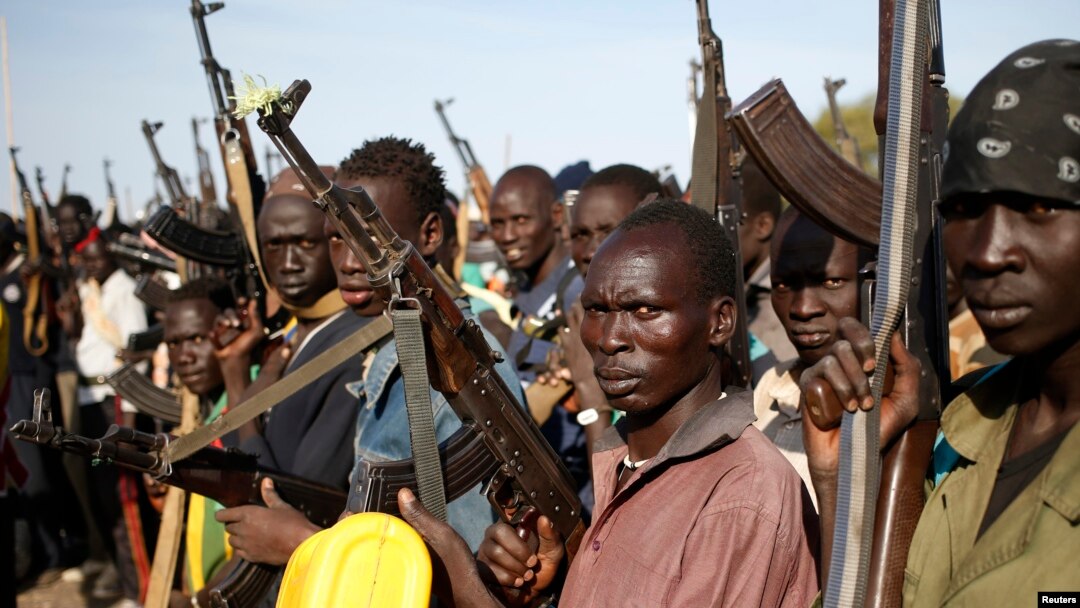NAIROBI, KENYA —
A report released by the Small Arms Survey documents evidence Sudan has been the primary supplier of mostly Chinese-made weapons to insurgent groups going back to conflicts surrounding South Sudan's eventual independence in 2011.
Report co-author Jonah Leff said those actions have helped supply armed groups involved in current fighting between South Sudan's government and rebel forces.
“A lot of the weapons that are circulating with the rebels, but also with the tribal militias such as the White Army and the Nuer youth, originate in Sudan," said Leff. "So a couple of years ago there were examples of Sudan arming various rebel groups that were then supplying these weapons on to tribal militias, and we have seen a number of these popping up.”
Simmering dispute
The White Army is an informal militia from the ethnic Nuer community that has supported rebel leader Riek Machar, also a Nuer.
A political dispute between Machar and President Salva Kiir, a Dinka, erupted in violence in December, dividing the armed forces along ethnic lines.
Leff said both sides of the conflict appear to be equally well-armed, as they originated from the same army. The question, he said, is how rebels have been able to re-supply ammunition.
“There have been ongoing battles since the middle of December, and there is no way they would have had sufficient quantities, stockpiles of ammunition to sustain that fighting,” she said.
Chinese, Iranian arms
Leff said Sudan still could be supplying group's linked to Machar, but he said getting access to equipment seized from the rebels is a challenge.
The report finds the majority of weapons, such as assault rifles and rocket-propelled grenade launchers imported by Sudan, are made in China, with a percentage coming from Iran. Sudan also is increasingly manufacturing its own weapons.
Sudan is under an arms embargo applied only to the Darfur region to limit supplies of weapons to government-aligned militia. A previous Small Arms Survey report in 2012 noted that despite the ban, all sides in that conflict “continued to gain access to military resources.”
Meanwhile, the report says that tracing arms flows is becoming more difficult as serial numbers and other identifying marks are being deliberately scraped off of weapons found in conflict zones.
Report co-author Jonah Leff said those actions have helped supply armed groups involved in current fighting between South Sudan's government and rebel forces.
“A lot of the weapons that are circulating with the rebels, but also with the tribal militias such as the White Army and the Nuer youth, originate in Sudan," said Leff. "So a couple of years ago there were examples of Sudan arming various rebel groups that were then supplying these weapons on to tribal militias, and we have seen a number of these popping up.”
Simmering dispute
The White Army is an informal militia from the ethnic Nuer community that has supported rebel leader Riek Machar, also a Nuer.
A political dispute between Machar and President Salva Kiir, a Dinka, erupted in violence in December, dividing the armed forces along ethnic lines.
Leff said both sides of the conflict appear to be equally well-armed, as they originated from the same army. The question, he said, is how rebels have been able to re-supply ammunition.
“There have been ongoing battles since the middle of December, and there is no way they would have had sufficient quantities, stockpiles of ammunition to sustain that fighting,” she said.
Chinese, Iranian arms
Leff said Sudan still could be supplying group's linked to Machar, but he said getting access to equipment seized from the rebels is a challenge.
The report finds the majority of weapons, such as assault rifles and rocket-propelled grenade launchers imported by Sudan, are made in China, with a percentage coming from Iran. Sudan also is increasingly manufacturing its own weapons.
Sudan is under an arms embargo applied only to the Darfur region to limit supplies of weapons to government-aligned militia. A previous Small Arms Survey report in 2012 noted that despite the ban, all sides in that conflict “continued to gain access to military resources.”
Meanwhile, the report says that tracing arms flows is becoming more difficult as serial numbers and other identifying marks are being deliberately scraped off of weapons found in conflict zones.



